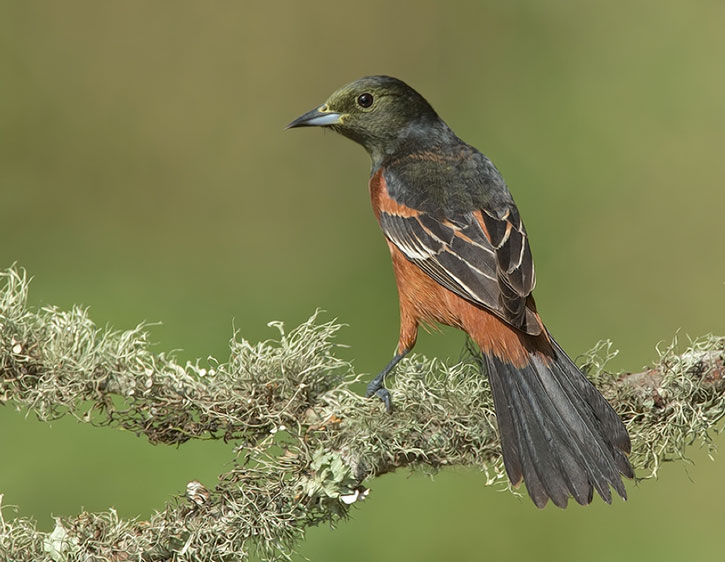The Orchard Oriole is a slender songbird. They have rounded heads, straight, pointed bills, and medium-length tails.
Orchard Oriole is the smallest Oriole in North America; it builds pouchlike, hanging nests during its short breeding season.
Once the breeding season is over, they head back to Central America for the rest of the year.
On this page
Identification
Adult male Orchard Orioles are reddish-chestnut below and black above. Additionally, they have a reddish-chestnut patch on the wing and a black throat and head.
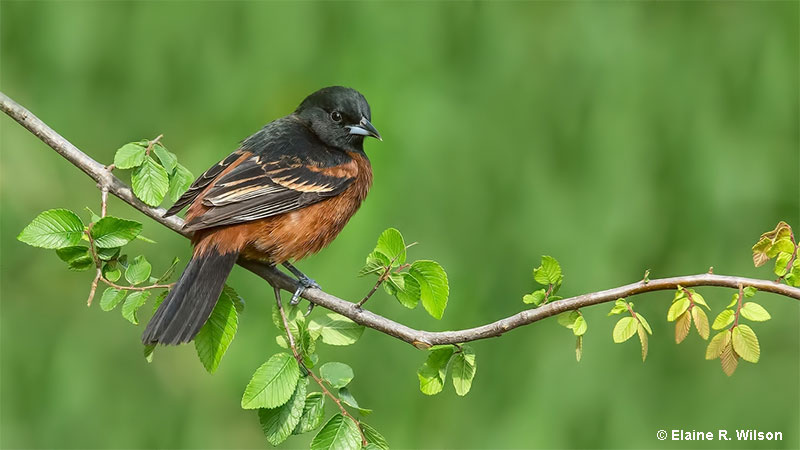
Male. © 2016, Elaine R. Wilson
Orchard Orioles measure between 5.9 to 7.1 inches in length, weigh approximately 0.6 to 1.0 ounces, and possess a wingspan of around 9.8 inches.
Female Orchard Orioles display prominent differences compared to breeding males. They have two white wing bars and a greenish-yellow coloration overall.
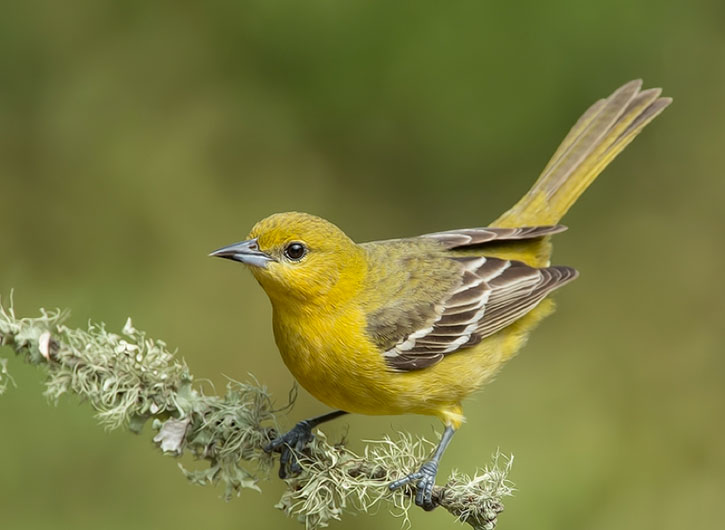
Female Orchard Oriole. Photograph © Alan Wilson.
However, in terms of size, length, wingspan, and weight, they are identical to breeding males. Juvenile male Orchard Orioles share a resemblance to females, with two white wing bars and a greenish-yellow appearance.
However, they do have a minor distinction of black coloring around the throat and bill.
Food
Orchard Orioles primarily consume arthropods like insects. Additionally, they supplement their diet with nectar and fruit. They glean insects from foliage, including ants, parasitic wasps, caterpillars, crickets, grasshoppers, beetles, spiders, and mayflies. They’ll drink nectar from hummingbird feeders and flowers.
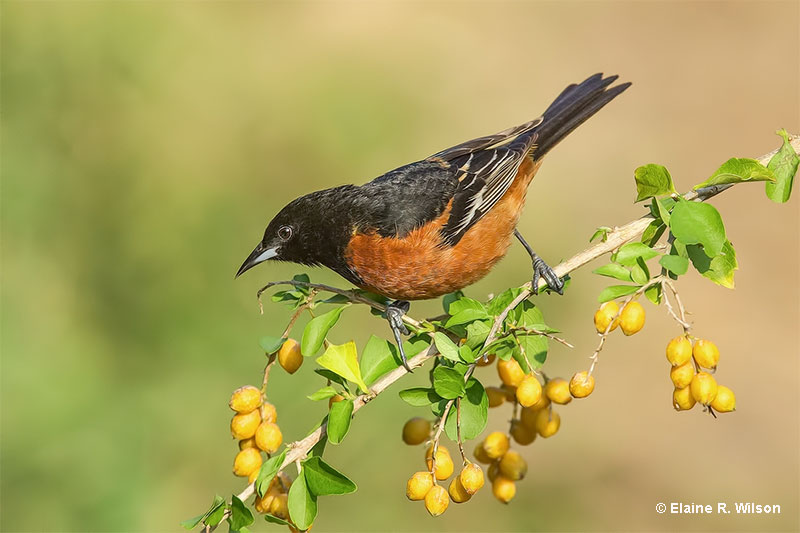
© Elaine R. Wilson
When feeding from flowers, they’ll get to the nectar in a couple of ways. They’ll sometimes duck their head into the opening of the flower; other times, they’ll pierce the flowers at the base.
Their diet changes to primarily fruit right before migrating in the fall.
Flocks that are migrating forage on chokecherries, ripe mulberries, along with other berries. They feed on pollen, nectar, and fruits on their wintering grounds in Central America.
Orchard Orioles won’t visit backyard bird feeders that contain seeds. Since these birds are also insectivores, a backyard with shrubs may provide enough spiders and insects to attract them.
Nesting and Eggs
Orchard Orioles are more versatile than other birds when it comes to nesting locations; they opt for a range of tree species, such as ash, maple, cottonwood, elm, and oak, to name a few. Nests can be found at different heights and are typically constructed on branches that are forked away from the tree trunk, ensuring secure attachment.
When it comes to nest construction, it is primarily the female birds that take on the responsibility. It will take her about a week to finish the nest. The nest is woven from blades of grass that are yellow and dry.
The nest is usually lined with plant down, fine grasses, catkins, animal wool, cotton, feathers, and pieces of yarn. The external dimensions of their nests are 3 inches in height and 4 inches in width. The inner cup of the nest has a height of 2 inches and a width of 2.5 inches. The nest material is loosely woven, allowing the eggs to be visible through it.
Orchard Orioles have 1 to 2 broods during the breeding season. They incubate their eggs around 12-14 days.The eggs themselves are characterized by a gray or light blue color, adorned with dark gray, brown, purple, or black splotches.
Current Situation
Orchard Orioles are relatively common. Between the late 1960s and 2019, the population has been steadily declining by over 1% annually. They have an estimated population of 12 million, and according to the IUCN Red List, they have a stable population and are a species of least concern.
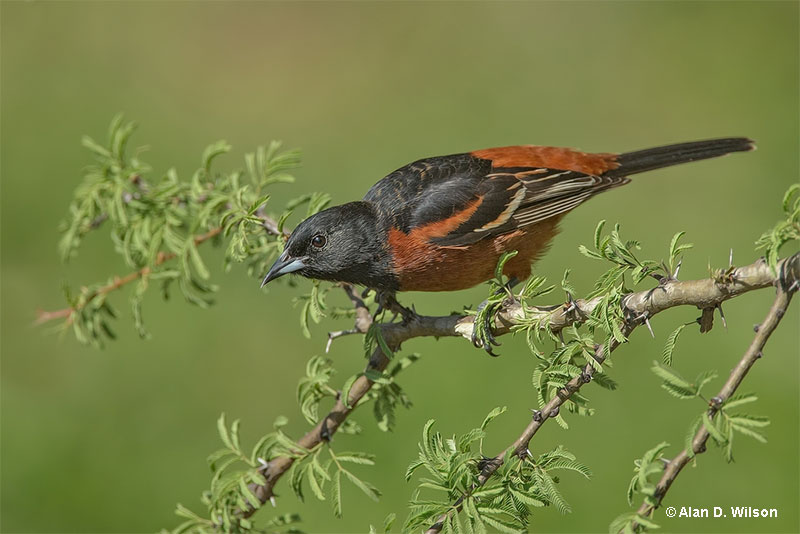
© Alan D. Wilson
In Texas and Louisiana, Orchard Orioles face significant parasitism by cowbirds. In fact, this caused them to experience population declines throughout the 1900s. Additionally, the loss of suitable habitats poses another potential challenge for these birds.
Look for these birds along river edges in open woodlands, as well as lakeshores, marsh edges, farms, and open shrublands. In open habitats, they nest in scattered trees. Orchard Orioles winter in tropical forest edges, thickets, plantations, lightly wooded areas, and shady pastures.
Facts
- The Orchard Oriole is the smallest oriole in North America. They’re often confused for warblers because of their bright color and small size.
- Orchard Orioles won’t visit backyard bird feeders. However, you can attract them to your yard with fruit jelly, sliced oranges, and hummingbird feeders. Since these birds are also insectivores, a backyard with shrubs may provide enough spiders and insects to attract them.
- Orchard Orioles are not aggressive by nature. They display remarkable tolerance towards birds of their own species as well as other species. You’ll find that they choose to nest in close proximity to Bullock’s Orioles, Baltimore Orioles, Chipping Sparrows, Eastern Kingbirds, and American Robins, forming a harmonious community.
- When Orchard Orioles fly, they usually stick close to the ground. They don’t fly above the tree canopy.
- The Orchard Oriole has a diet that includes nectar and pollen from flowers. Because of this, they’re vital pollinators for certain tropical tree species. They effectively transfer pollen from one flower to another with their heads due to the pollen sticking when feeding.
Similar Species
The Orchard Oriole has features that are similar to other bird species. Here are some similar species:
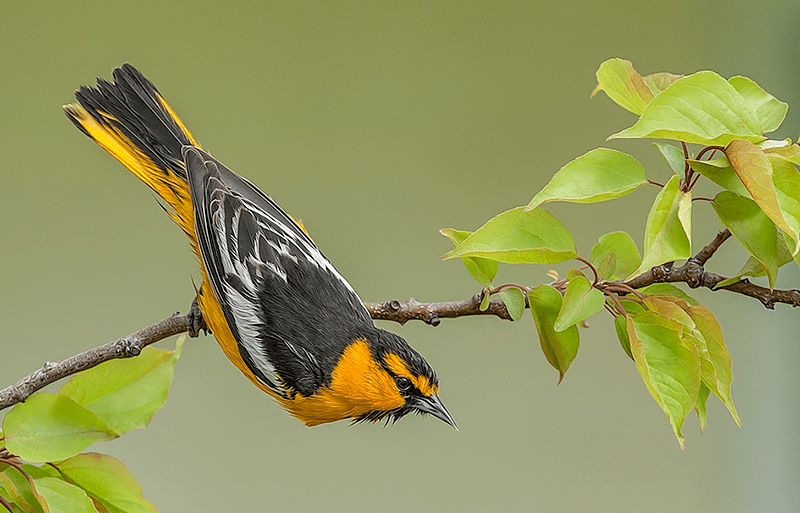
Photograph © Alan Wilson.
Bullock’s Oriole
Female Orchard Orioles are greenish-yellow overall and have greenish-yellow bellies. Bullock’s Orioles are more orangish overall and have whiter bellies.
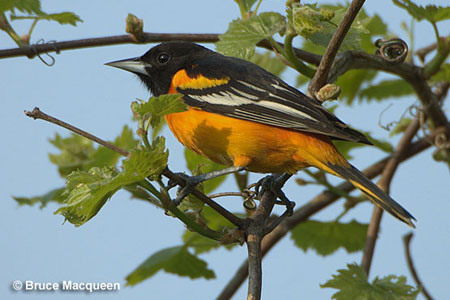
Baltimore Oriole
Baltimore Oriole
While Baltimore Orioles and Orchard Orioles have markings that are similar, there’s a notable distinction between male Baltimore Orioles and male Orchard Orioles.
The Baltimore Oriole has a vibrant burst of orange, while the Orchard Oriole has a darker chestnut hue.
See more: Birds that look like orioles
Additionally, Baltimore Orioles have a wingspan that’s nearly 12 inches long, while Orchard Orioles have a wingspan of just over 9 inches.
Frequently Asked Questions
Are Orchard Orioles rare?
No, Orchard Orioles are not rare. Their estimated breeding population is 12 million and can be found across a good portion of North America, making them a widespread bird.
Where are Orchard Orioles found?
Orchard Orioles can be found along river edges in open woodlands, as well as lakeshores, marsh edges, farms, and open shrublands. In open habitats, they nest in scattered trees. Orchard Orioles winter in tropical forest edges, thickets, plantations, lightly wooded areas, and shady pastures.
Where do Orchard Orioles migrate to?
Orchard Orioles are long-distance migrants. They fly from the eastern portions of North America to wintering grounds in northern South America and Mexico.
What is the difference between a Baltimore Oriole and an Orchard Oriole?
Adult Male Orchard Orioles are rich chestnut, while adult male Baltimore Orioles are bright orange. Additionally, adult Female Orchard Orioles are greener than Baltimore Orioles and don’t have the orange on the breast and tail that adult female Baltimore Orioles have.
How long do Orioles live for?
Orchard Orioles have an average lifespan of 9 years. However, there have been cases of these birds living to be older than that. The oldest Orchard Oriole on record lived to be at least 11 years old.

